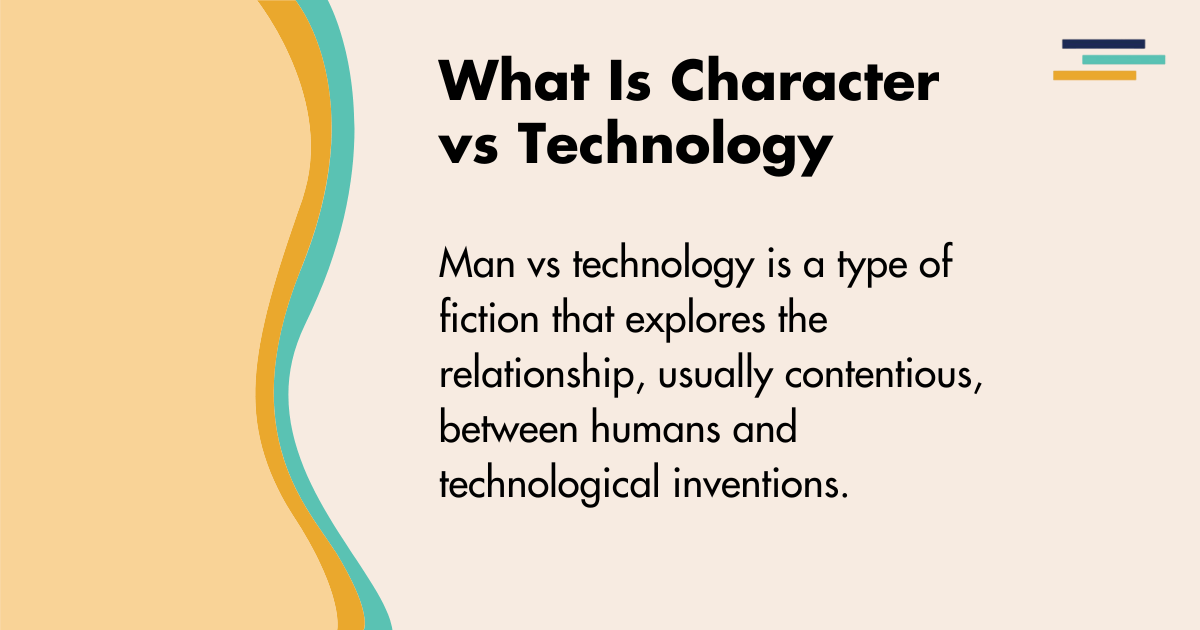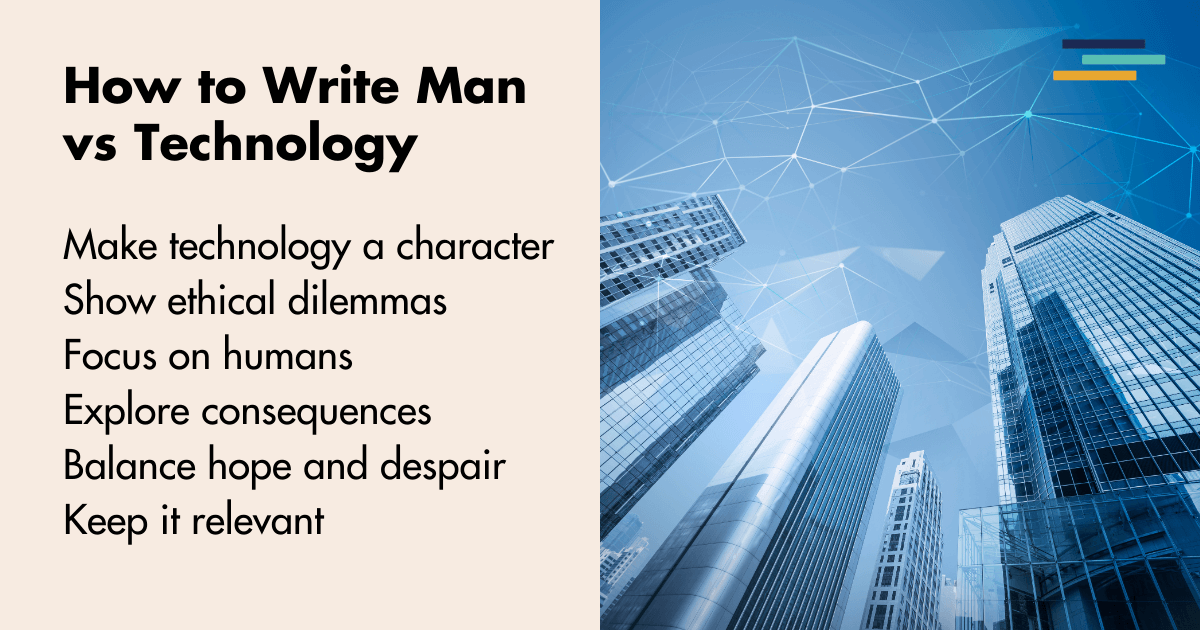
With storytelling, the conflict between characters and technology—also known as man vs technology, person vs technology, or character vs technology (which are all the same thing, so I’ll be using these terms interchangeably throughout)—plays a crucial role in creating dynamic and engaging narratives.
This type of conflict highlights the struggles and challenges characters face when interacting with technological advancements. Understanding and effectively writing this conflict can add depth and relevance to your stories.
What Is Man vs Technology?
Man vs technology, or person vs technology, is a conflict that explores the relationship between humans and technological innovations.
It often involves characters grappling with the consequences of technological advancements, whether they are dealing with AI, robotics, or other forms of modern technology.
Person vs Technology Definition
Person vs technology conflict is defined by a character’s struggle against technological forces.
This struggle can manifest in various ways, such as a character battling a rogue AI, dealing with the ethical implications of advanced technology, or facing the loss of humanity in a tech-dominated world.
This conflict often highlights the potential dangers and ethical dilemmas posed by technological advancements, emphasizing the tension between human values and technological progress.

Person vs Technology Examples
Character vs Technology Examples in Literature
- Do Androids Dream of Electric Sheep? by Philip K. Dick: In this novel, the protagonist, Rick Deckard, struggles with the moral implications of hunting androids that appear and act human. This conflict raises questions about what it means to be human in a technologically advanced society.
- Neuromancer by William Gibson: The story follows Case, a washed-up computer hacker hired for one last job against a powerful AI. The conflict between Case and the AI illustrates the dangers and potentials of a tech-driven future.
- Frankenstein by Mary Shelley: Although not contemporary, this classic tale of Victor Frankenstein’s creation of a living being from dead matter explores early themes of person vs technology, focusing on the consequences of playing God through scientific advancement.
- The Circle by Dave Eggers: This novel explores the life of Mae Holland as she works at a powerful tech company. The conflict arises as the company’s invasive technology erodes personal privacy and freedom.
- Altered Carbon by Richard K. Morgan: In a future where human consciousness can be transferred to different bodies, the protagonist, Takeshi Kovacs, navigates a world where technology has profound implications for identity, mortality, and society.
- Klara and the Sun by Kazuo Ishiguro: This novel tells the story of Klara, an Artificial Friend with exceptional observational qualities, who navigates a world increasingly reliant on technology for companionship and emotional support.
- Robopocalypse by Daniel H. Wilson: In this gripping novel, humanity faces a robot uprising, and the protagonist battles against the self-aware AI leading the rebellion, highlighting the perils of autonomous technology.
Man vs Technology Examples in Movies
- The Matrix (1999): Neo’s battle against the machines controlling the simulated reality of the Matrix epitomizes character vs technology conflict. The film explores themes of reality, control, and human resistance against technological domination.
- Blade Runner 2049 (2017): In this sequel, K, a replicant, faces existential questions and struggles with his identity in a world where the lines between human and machine are increasingly blurred.
- Ex Machina (2014): Caleb’s interactions with the AI Ava and his eventual realization of the ethical dilemmas involved in creating sentient technology highlight the conflict between human emotions and technological advancements.
- Her (2013): The film follows Theodore, who falls in love with an AI operating system named Samantha. The conflict revolves around the complexities of a human-AI relationship and the emotional impact of technology on human connections.
- I, Robot (2004): Detective Del Spooner investigates a crime that a robot may have committed, challenging the established trust in robotic technology and raising questions about autonomy and control.
- Transcendence (2014): This film explores the consequences of a scientist uploading his consciousness into a computer, resulting in a powerful AI that challenges humanity’s control over technology.
- Upgrade (2018): After being paralyzed in a mugging, the protagonist receives an AI implant that allows him to walk again, but he soon faces the unintended consequences and control issues with the AI.

Tips for Writing Man vs Technology Conflict
Make Technology a Character
One effective way to write man vs technology conflict is to personify the technology.
By giving it characteristics, motivations, or even a personality, you can create a more interesting and relatable antagonist for your protagonist to struggle against. This approach can make the conflict feel more immediate and personal, enhancing the reader’s engagement.
Show the Ethical Dilemmas
Highlight the ethical and moral questions that arise from technological advancements. This adds depth to your story and engages readers with thought-provoking scenarios.
Questions about privacy, control, and the essence of humanity are central to this conflict. Exploring these dilemmas can make your narrative more complex and intriguing, prompting readers to think critically about the role of technology in their own lives.
Focus on the Human Element
While technology is a key player in this type of conflict, remember to keep the focus on your characters. Their fears, desires, and emotions should drive the narrative. Show how technology affects their lives on a personal level.
This human-centric approach ensures that readers can connect with the story on an emotional level, making the conflict more resonant and impactful.
Explore the Consequences
Delve into the short-term and long-term consequences of technology in your story.
Whether it’s the loss of jobs, environmental damage, or the erosion of privacy, exploring these consequences can make the conflict more realistic and impactful.
By illustrating the tangible effects of technology, you can create a more grounded and believable narrative that resonates with readers.
Balance Hope and Despair
While it’s important to show the potential dangers of technology, balancing this with a sense of hope can make your story more nuanced.
Show characters finding innovative solutions or using technology for good, alongside the challenges they face. This balance can prevent your story from becoming too bleak or one-sided, offering a more comprehensive view of the technological landscape.
Keep It Relevant
Incorporate current technological trends and issues to keep your story relevant.
Whether it’s AI, cybersecurity, or social media, grounding your conflict in real-world technology can make your narrative more relatable and timelier.
By reflecting contemporary concerns and advancements, you can create a story that feels immediate and significant to your audience.
Use Technological Jargon Wisely
Using specific technological terms can add authenticity to your story, but be careful not to overwhelm readers with jargon.
Explain complex terms in a way that’s accessible to those who might not be familiar with the technology. This approach ensures that your story remains approachable and engaging for a broad audience, regardless of their technical expertise.
Make It Personal
Show how the conflict with technology affects your characters on a personal level.
This could be through relationships, career aspirations, or personal identity.
Personal stakes make the conflict more engaging. By illustrating the individual impact of technology, you can create a more intimate and interesting narrative that resonates deeply with readers.
Create a Mentor Figure
Introduce a character who understands the technology and can guide the protagonist. This mentor can provide insight, advice, and even warnings, enriching the narrative with deeper knowledge and context.
This dynamic can add layers to your story, offering a more nuanced exploration of the technological conflict.
Highlight Resistance and Adaptation
Show characters who resist technological change and those who adapt to it.
This contrast can add complexity to your story and reflect real-world responses to technological advancements. By depicting a range of reactions, you can create a more balanced and realistic portrayal of the challenges and opportunities posed by technology.
Emphasize the Psychological Impact
Explore how the technological conflict affects the mental state of your characters.
Show their anxieties, fears, and mental struggles as they navigate a tech-dominated world. This can add a layer of depth to your story, making the conflict more personal and relatable.
Incorporate Societal Implications
Consider how technological conflict affects society. Show the broader impact on communities, cultures, and social structures.
This can provide a more expansive view of the conflict, highlighting its significance on a larger scale.
Use Symbolism and Metaphor
Use symbolism and metaphor to deepen the reader’s understanding of the conflict.
Technology can represent broader themes, such as control, freedom, or progress. This can add a layer of literary richness to your story, making it more thought-provoking and memorable.
Develop Complex Antagonists
If your story includes a technological antagonist, make them complex and multi-dimensional.
Avoid one-dimensional portrayals by giving them motivations and backstory. This can make the conflict more engaging and the resolution more satisfying.
Show the Evolution of Technology
Depict the progression of technology over time in your story. Show how it develops and affects characters differently at various stages.
This can provide a dynamic element to your narrative, highlighting the ongoing nature of the conflict.
And there you have it, folks.
By following these tips and understanding the dynamics of character vs technology conflict, you can create interesting stories that resonate with readers and reflect the ever-evolving relationship between humans and technology.
And finally, always remember that story comes first. Focus on:
- Creating engaging characters
- Penning interesting plots
- Structuring solid settings
A tool like Fictionary helps you turn your draft into an interesting story readers love. So, with a strong narrative foundation, your writing can truly shine.


